
Hagoita-Ichi Fair 2025
Gloria TicconiAt Senso-ji temple in Tokyo's historical Asakusa district, you can buy traditional decorated bats at the Hagoita-Ichi Fair, held every December.

Senso-ji Temple (浅草寺, Sensōji) is a popular spot for omikuji, or fortunes. These auspicious sheets are offered in a multitude of languages, enticing both Japanese and foreigners alike to see how their luck plays out. If the number you draw is less than lucky, don’t worry – simply tie up the offending fortune on the nearby wires and allow your bad karma to be spirited away.
The temple also shares its grounds with the Asakusa Shrine, dedicated to the three men credited with the temple’s founding. Considered one of the oldest original buildings in Tokyo, the shrine plays host to the exuberant Sanja Matsuri every May. Another popular building (and photo spot) is the five-story pagoda
A number of other festivals take place at Senso-ji throughout the year. The Kinryu-no-mai (Dragon Dance) can be enjoyed on March 18th and October 18th, when a large golden dragon on poles is paraded through the streets. Visitors on April 14th can witness the Sagi-no-mai (White Heron Dance), which features a parade of participants in both Heian-era outfits and heron costumes. In late autumn, the temple’s atmosphere grows even more exuberant during its end of the year rake fairs. Buyers come to purchase one of the many colorfully adorned tools in the hopes of raking in good fortune in the coming year.
It is arguably one of the most popular tourist destinations in the city, Senso-ji Temple – also known as Asakusa Kannon – can trace its roots back to the early 600s. In 628, two fishermen on the nearby Sumida River repeatedly brought up a golden statue of the Buddhist goddess of mercy along with their usual catch. Finally deciding not to throw the statue back to the depths of the river once more, they instead brought it to their village headman, who convinced them to build a temple in its honor. Senso-ji Temple was finished in the year 645 and quickly became a pilgrimage site.
Its popularity endured over the centuries and even continues in the present day, with most visitors making this one of their first stops in Tokyo. The road leading up to the temple, known as the Nakamise-dori or “street of inner shops”, peddles everything from lacquered chopsticks and ukiyo-e prints to cheap keychains and colorful trinkets. Cake-like ningyoyaki¸sweet treats that are served hot off the iron grill, are a popular purchase, as are warming cups of amazake in the winter months.
Nakamise-dori is the street people walk on the approach to Senso-ji. Said to have been born in the 18th century as shop keepers were granted permission to sell their wares along the way to the temple. Today, the 250-meters contains around 90 shops and sells everything from souvenirs to snacks, meals and yukata.
Kaminarimon, literally Thunder Gate, is the outer of two large entrance gates that lead to Senso-ji. The gate houses a large red lantern with a wooden carving of a dragon on the underside as well as two large statues, Fujin (god of wind) on the right and Raijin (god of thunder) on the left.
Hozomon is the inner gate, Kaminarimon being the outer, and houses many of Senso-ji’s treasures. The first story houses two large statures of Nio, the guardian deities of the Buddha; there are also three lanterns and a pair of large sandals.
The impressive five-story pagoda is easily visible as you walk along the path to Senso-ji and worth a visit—and especially worthy of some photographing. It is the second highest pagoda in Japan at 53 meters high and was built in 942 to hold Buddha’s ashes given as a goodwill to Japan from Sri Lanka.
Five-minute walk from Asakusa Station on the Ginza Subway Line, Asakusa Subway Line, and Tobu Railways.

At Senso-ji temple in Tokyo's historical Asakusa district, you can buy traditional decorated bats at the Hagoita-Ichi Fair, held every December.
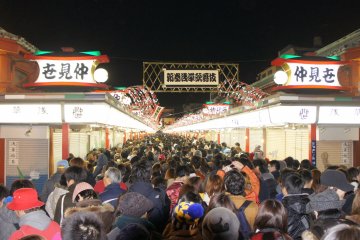
The first visit to the shrine in the new year is called Hatsumode, and it attracts quite some crowds every year, and I think it is a great way to start a new year in Japanese-style.
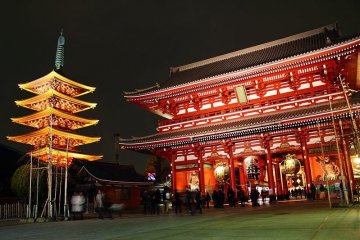
Sensoji is the famous Asakusa Kannon Temple in Taito-ku Tokyo

Nakizumo Crying Baby Festival 2019 in Asakusa's Senso-ji, an unusual but popular festival among parents where babies, carried in the arms of sumo wrestlers, compete by crying for the sake of good health and to drive away evil spirits.
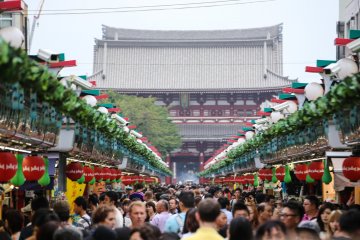
The hustle and bustle of a major Japanese temple in Tokyo. Senso-ji is good anytime of the year.
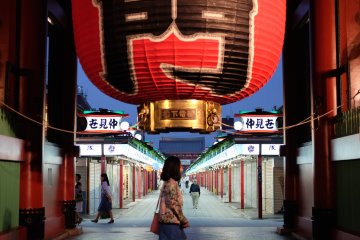
Experience a different side of Asakusa at night
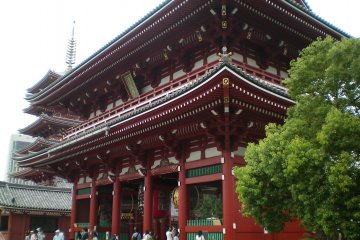
Sensoji Temple, built in the 7th century, is a Buddhist temple adorned in history and a modern-day Asakusa landmark.

According to a legend, Sensoji was built in 628 on the exact location where two brothers fished the golden statue of Kannon, the goddess of mercy, out of the Sumida river. The temple was completed in 645. Actually it is the largest and oldest Buddhist temple in Tokyo. With millions of visitors every year it is an awesome experience for all visitors.
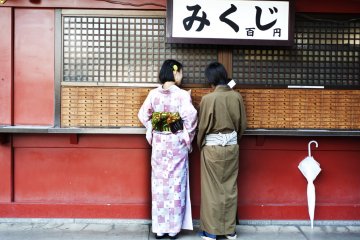
Rituals of Fountain and incense cleasing, and omikuji fortune, in Sensoji Temple
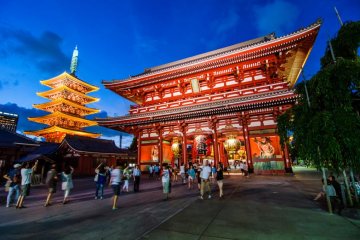
Photos from Tokyo's Sensoji Temple in the Asakusa District

Sensoji is a famous buddhist temple in Tokyo, built in the 7th century to house the golden statue of Kannon the goddess of mercy.


Information and photos of the Sensoji Temple in Asakusa, Tokyo.

Sensoji after dark is a completely different world from its daytime hustle-bustle. Walk through avenues of shops shuttered for the night, look up, and be awed.
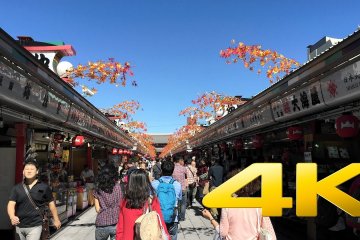
By far one of Tokyo’s most popular tourist attractions, the Sensō-ji is located in heart of Tokyo: Asakusa.
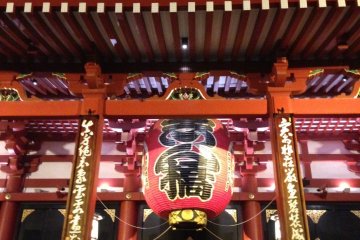
Sensoji Lightup in Asakusa: Quiet and peaceful Sensoji at night

Senso-ji is one of the oldest temples in Tokyo. Since the beginning of the Edo era, many people come here. The New Year's holidays especially are busy.
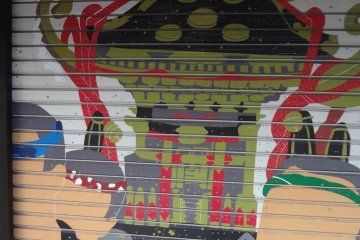
If you come early, before any of the shops open along the long street that leads to the temple from Kaminarimon Gate, you’re in for a real treat: Japanese Shutter Art

Omikuji are written fortunes offered at shrines and temples in Japan. Usually, omikuji require a small offering ( ¥100 usually), and are chosen randomly from a box. At Senso-ji Temple (Asakusa Kannon Temple), Tokyo's oldest temple, in Asakusa you can pick up an omikuji to try your luck.

Shirasagi-no Mai is a beautiful ceremonial procession performed at Senso-ji Temple and dates back over 1000 years.

At Senso-ji temple in Tokyo's historical Asakusa district, you can buy traditional decorated bats at the Hagoita-Ichi Fair, held every December.

The first visit to the shrine in the new year is called Hatsumode, and it attracts quite some crowds every year, and I think it is a great way to start a new year in Japanese-style.

Sanja Matsuri is one of Tokyo's biggest festivals and features over 100 mikoshi floats paraded through the grounds of Senso-ji temple.

Northern Tokyo holds a lot of charm with its ever so popular Buddhists temple, Sensoji. Directing you to this stunning temple is Nakamise, an over 200 meter street with an abundance of traditional and exciting foods, and friendly people welcoming you to one of Tokyo's most loved sites.
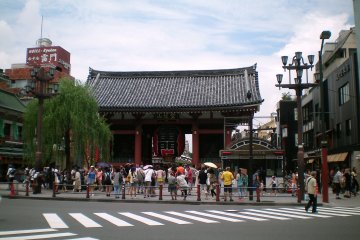
Kaminarimon Gate, standing at the entrance of Sensouji Temple, is Asakura's most famous landmarks.
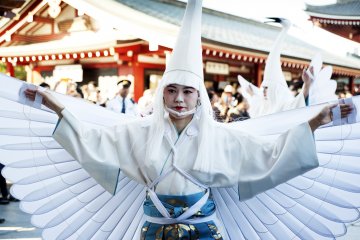
Shiragagi-no-mai, a millennium-old dance in Sensoji Temple in Asakusa

Asakusa is famous for its annual year-end Hagoita (Battledore) Fair held December 17-19. It started in the late 16th century on the grounds of Senso-ji Temple.
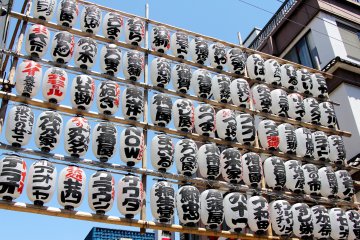
During the festival the area around Asakusa's Sensoji Temple is filled with hundreds of people. There are drums and people playing the flute as well as people yelling from time to time. Also a great time to enjoy the numerous food stalls where you can purchase many different foods, desserts and drinks of course.
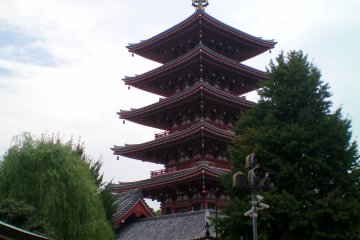
Five-story Pagoda located near Sensouji Temple in Asakura, Tokyo.
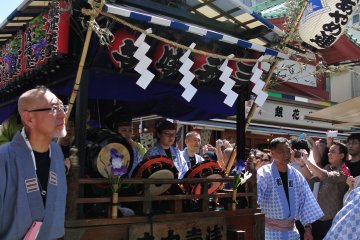
Enjoy an Edo Period parade at the Sanja Matsuri held in Asakusa in May
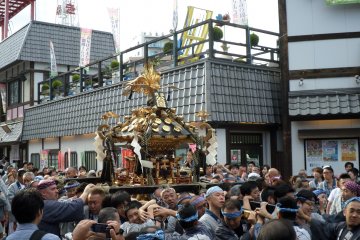
Sanja Festival is a jam-packed, three-day celebration in Asakusa that is worth fighting through the crowds for.
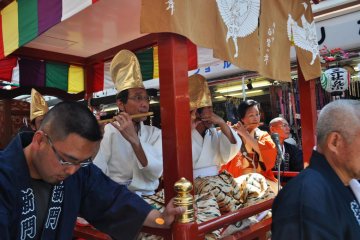
Take a glimpse into traditional Japanese culture at the Sanja Festival held annually in Tokyo.

A few suggestions on how to make your day extra smooth at the Asakusa Nakamise shopping street and the famous temple, Senso-ji.


If you're not in the Aomori area during the summer months to experience the Hirosaki Neputa Festival, head to Tokyo's Asakusa area this November. The Hirosaki Neputa Asakusa Festival brings some stunning lantern floats to Tokyo's Sensoji Temple for attendees to marvel at.

This December, Tokyo’s historic Sensoji Temple will host Asakusa Culture & Lights, an illumination event combining ancient tradition with cutting-edge technology.

NOHGA HOTEL AKIHABARA TOKYO is conveniently located in the midst of the electric town Akihabara, also known as the capital of manga and anime. In addition, this neighborhood has an abundance of tech shops, maid cafes and a variety of restaurants. With just a 6-minute walk away from Akihabara station, it provides easy access to explore other areas nearby such as Ueno and Asakusa. This hotel embodies the rich cultures of music, art and food. Nohga’s concept of music is derived from Akihabara’s local history, starting as a district of radio and wireless component merchants in the late 1920s. The artistic and luxurious space throughout the hotel is achieved by featuring art and amenities designed in collaboration with craftsmen from around Japan. As for the food menu, it’s seasonal fresh ingredients are sourced domestically. The glasses and dinnerware served are collaborations with stores in the surrounding area. All 120 non-smoking guest rooms feature an ensuite bathroom with a rain shower, in-room safety box, mini fridge, USB plugs, free Wi-Fi, a high-quality bluetooth speaker and flatscreen TV with original music and film. The lounge area and a compact 24-hour gym can be found near the reception on the second floor. Services include laundry (from 2,750JPY) and a 24-hour front desk with a check-in time of 3PM and check-out time of 11AM. For sightseeing you can rent a Tokyobike for the day (2,000 JPY/day) to explore the vicinity.
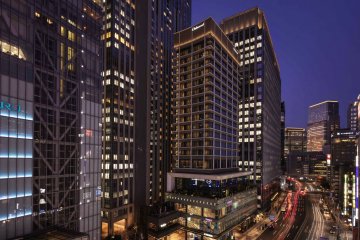
Oakwood Premier Tokyo comes from a brand of standout luxury hotel & service apartments right at the heart of the Tokyo metropolis. It is located in the business hub of Marunouchi with JR Tokyo Station in close proximity. This will allow guests and travelers to easily access the city's extensive transport network and visit various landmarks such as Imperial Palace, Tsukiji Fish Market, Ginza and Shopping District. Boasting 123 luxurious apartments on the upper floors of a multi-serviced complex, each room offers a magnificent view of the city, not to mention all furnished and a fully-equipped kitchen set which is rarely seen in your everyday service apartment. Without doubt, these spacious tranquil retreats are curated to give you the amenities and services of a luxury hotel and a feeling of home. They are good options for both business executives and leisure travelers from one night of a short-stay to a few weeks/months of mid-to-long-term stay.

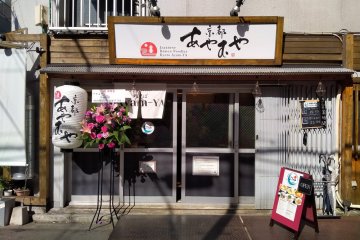
Ayam-YA is a certified halal ramen restaurant found in the Okachimachi area of Tokyo, between Asakusa and Ueno, and not far from Assalaam Mosque. A sister branch in Kyoto also exists.
![Moomin House Cafe Tokyo Skytree Town Solamachi [Closed] Moomin House Cafe Tokyo Skytree Town Solamachi [Closed]](https://a1.cdn.japantravel.com/photo/poi-254-212160/360x240!/tokyo-moomin-cafe-tokyo-skytree-town-solamachi-store-212160.jpg)
Enter the world of Moomin, the Finnish fairy-tale comic characters, in the exclusive Moomin Café in Tokyo Skytree Town. This permanent Moomin Café is specially designed for Moomin fans and offers dishes, desserts, drinks and decorations on the Moomin theme. Whether you are alone or eat in company, a plush Moomin figure will keep you company at the table. The figures of the Moomins are hippopotamus-like troll creatures and were invented by the writer Tove Jansson. They love in the idyllic Moomin Valley somewhere in Finland. The Moomin characters are very popular worldwide and their adventures have been translated into more than 30 languages. There is another highlight for real Moomin fans: The "Moominvalley Park" theme park was opened in March 2019 about 40 kilometers northwest of Tokyo in Saitama prefecture and offers further insights into the world of trolls.

Bunny Cafe Moff Rell in Tokyo's Chiyoda Ward offers a chance to interact with adorable rabbits. You can make reservations for the cafe by phone, or you can visit and pay at the store before entering. The cafe provides 30- and 60-minute courses, and you can play with or feed the bunnies. If you are unsure about how to treat the rabbits, don't worry! The staff members will kindly explain everything to you. Minimum age is 10 years old.

The Asakusa Culture Tourist Information Center (浅草文化観光センター, Asakusa bunka kankō sentā) is an eight story building designed by Kengo Kuma. The top floor contains a free observation deck and a cafe with views onto Sensoji temple and the Nakamise shopping street.
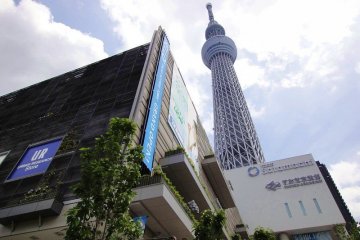
Tokyo Solamachi is a shopping, dining and entertainment complex at the foot of the famous Tokyo Skytree. It has more than 300 shops and restaurants and is well worth a visit even without the tallest tower in Japan. There are original Japanese souvenir shops, an official Tokyo Skytree shop, a large food market and food area, as well as many other restaurants and shops that invite you to extensive shopping. Tokyo Solamachi is also home to the Sumida Aquarium, a planetarium and many small green areas and terraces. The Postal Museum opened in March 2014 on the ninth floor. It has an extensive collection of postage stamps from around the world, as well as interactive exhibits and exhibits that show the history of postal services in Japan.

With a height of 634 meters, the Tokyo Skytree is Japan's tallest structure and a symbol of Tokyo. It is located in the northeastern part of Tokyo. The height of the tower is an allusion to both its current location and the history of the area: 634 is also a reading of the Japanese characters for "Musashi," the old name of the province in which the tower stands today. The Tokyo Skytree has two viewing platforms that offer spectacular views over Tokyo. The two closed decks are at heights of 350 and 450 meters respectively, making them the highest observation decks in Japan. The Tembo deck, the lower of the two decks, is 350 meters high and extends over three levels with great views from all floors. The higher Tembo Gallery (450 meters) consists of a sloping spiral-shaped ramp that increases in height as you go around the tower. You'll find many attractions inside the tower's observation decks, such as restaurants with skyline views and photo spots manned by staff. Attached to Skytree is an expansive shopping and sightseeing area called Solamachi. Filled with specialty shops ranging from salts to chopsticks, toys to t-shirts.